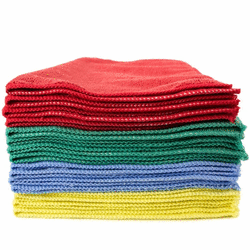Why use Microfiber Cloths & Mops?
- It’s Better! - Microfiber strands are split or “cracked” 10 times which creates a positive electric charge. The dirt and dust particles have a negative charge which makes them a perfect match — one who’s bond is super strong.
- It’s Healthier! - According to the EPA, microfiber leaves traditional mops in the dust when eliminating harmful bacteria. When bacteria culture is taken after cleaning with a microfiber mop, there can be up to a 99% reduction from pre-cleaning vs. just a 33%reduction when using regular cotton mops.
- Reduce mop costs by 60% - Microfiber mops can be laundered up to 500 times. Compare that to the 55-100 times of regular mops. For example, in 1 year, a hospital could see a 60% reduction in mop costs. Plus, more mops fit in 1 load of laundry, lowering water, detergent, and energy usage.
- Save 90-95% per day in product costs - Because of microfiber cloths’ increased efficiency and efficacy, you can experience water and chemical savings as much as 90%-95% per day, according to the EPA’s statistics.
- Lower labor costs by 20%/day – Using microfiber reduces fatigue while increasing square footage coverage and allows fewer trips to change water/solution. For example, in 1 year a hospital could see a 20% average custodial labor savings per day. When combined with the mop cost savings it can be more than $7,000 per year, per custodian!
Choosing the Right Microfiber Products
There is a wide range of microfiber cleaning cloths and mops due to the weight and pile, which is the length of the microfibers. GSM is the common measurement based off the weight and pile of the cloths.
- GSM – This stands for grams per square meter. Microfiber cloths vary greatly with a range from 50 to 600 GSM depending on the weight and pile. If you are looking to clean things like stove tops, tile floors, and walls, a higher GSM cloth is a better choice compared to something lower which might be used for lighter cleaning such as wiping down glass or mirrors.
Common Microfiber Options/Accessories - Cloths - Designed for general dusting, polishing, and cleaning. The cloths absorb dust and dirt without leaving streaks much more efficiently than cotton. Microfiber cloths can also be used with cleaners, sprays, polishes and water solutions. Some of the common cloth usages would be for cleaning bars, counters, and tables.
- Mitts - Ideal for dusting, polishing glass, and cleaning both wet and dry spills. Microfiber mitts fit easily over hand while keeping dry. Another cool feature of the mitts is the fact that they can be used with various cleaners, sprays, and polishes. Some of the common usages for microfiber mitts would be hard to clean areas and crevices that might be tough with a cloth
- Wet Mops - Designed to clean greater surface areas such as hospital, restaurant, and store floors. Mops generally require less water and chemicals while maintaining its non-abrasive and gentle characteristics. Wet mops are best used for hardwood, tile, vinyl, and linoleum floors.
- Dry Mops - Perfect for hard surfaces such as restaurant, kitchen, and diner surfaces. The benefit of having a large, looped fringe on the dry mop keeps dust from flying. Dry mops are ideal for cleaning various floors, ceilings, and fan blades
Who uses Microfiber? Commercial microfiber mops and cloths use in hospital and hotel janitorial departments is growing due to microfibers long-term economy, color-coding to lessen cross-contamination, and ability to efficiently eradicate bacteria. The automotive industry adopted commercial microfiber cloths for their streak-free properties and lint-less finishing. Microfiber sheets, pillowcases, and throws are economical, soft, and durable. Perfect for hard wearing modern families.
Microfiber Colors Color-coding reduces cross contamination risks by keeping common area products separate from high risk zones. All of our products are available in multiple colors to ensure a smooth process. Below is an example of how custodians eliminate color contamination. - Red – bathroom, washroom
- Yellow – medical procedure areas
- Blue – common areas/ high-touch surfaces
- Green – food service
How to clean Microfiber mops & cloths? To preserve the life of your microfiber wash and dry after use. Otherwise you run the risk of contaminants setting in the cloth. This will hamper future cleaning efforts by clogging the fine cleaning channels and increases the risk of cross contamination. 1. Wash the most soiled microfiber in separate loads. This is most easily done when using a color coordinated system as some tasks are dirtier than others. 2. Wash microfiber only with other microfiber as cotton releases lint that is trapped within the microfibers. 3. Program commercial laundry washing machines with the following cycle for optimum results. Use more solvent for heavily soiled cloths, never use alkaline, bleach, or fabric softener as these will remove the positive charge that has been infused into the microfiber, rendering the cloth less efficient.
Microfibers are more susceptible to damage due to heat. Their polyamide material could deform when in contact with hot dryer drums. If you insist on machine-drying, set the temperature to a maximum of 140°F and remove immediately following the dry cycle. When ‘drying’ microfiber you have three options. - Preferred option: Air dry.
- Do not dry, add disinfectant during the 80°F rinse cycle then seal mops in a poly bag for transportation.
- Commercial laundries may pre-load wet-mops with a chemical product by placing them in a container with cleaning chemicals. In 30 minutes you will have a saturated wet mop that’s ready to quickly deploy in a soiled area.
|

